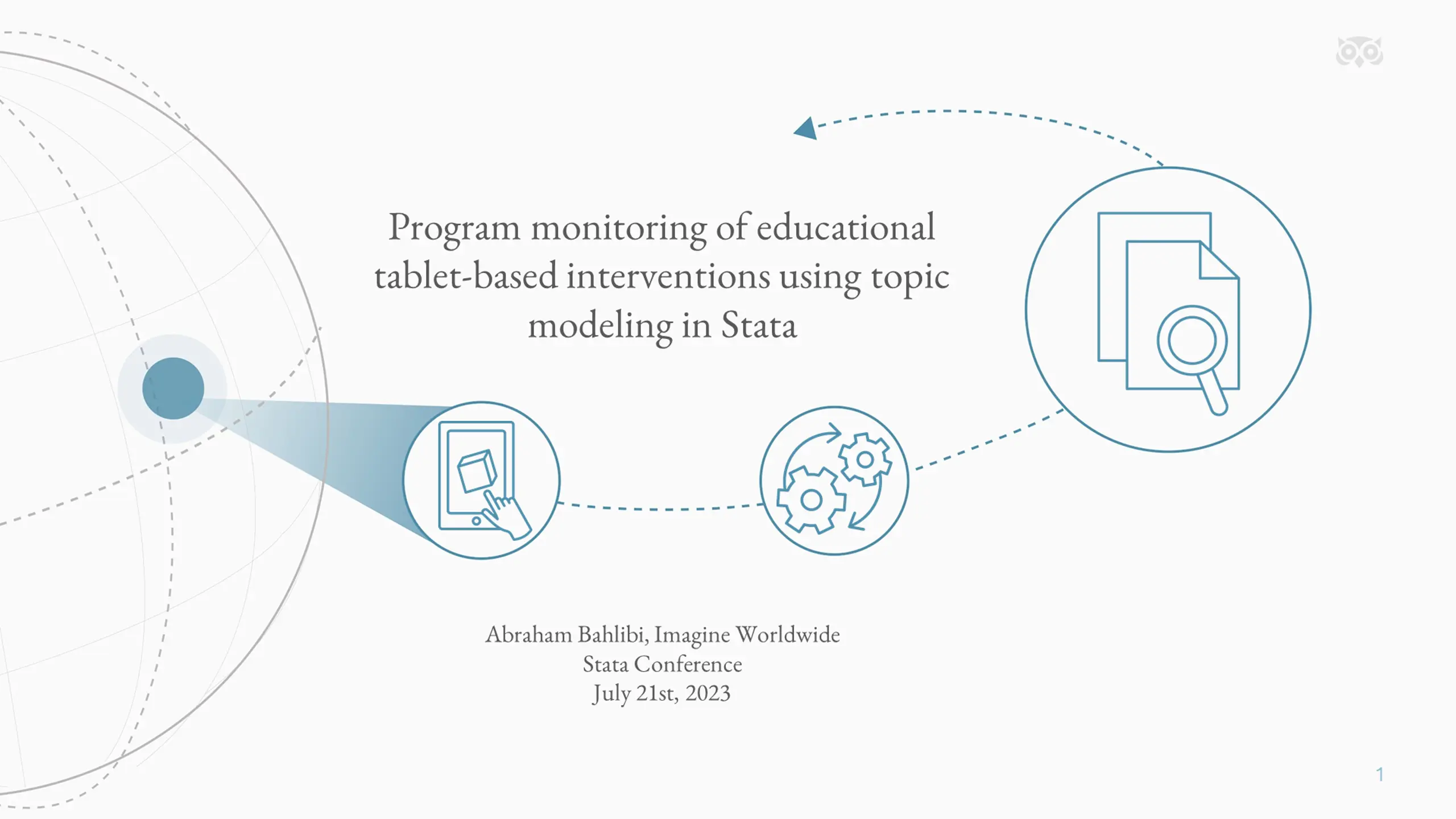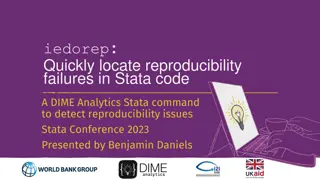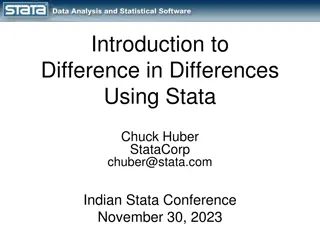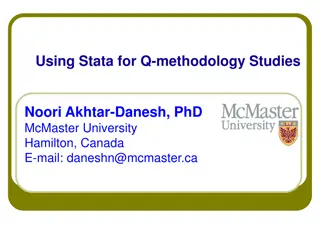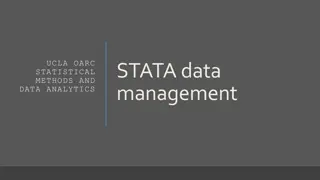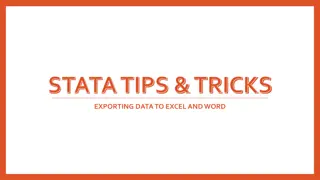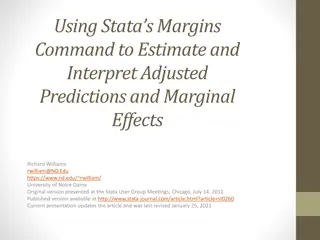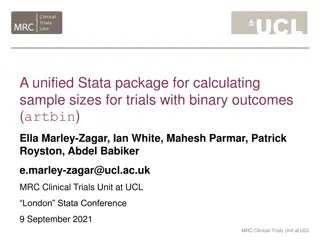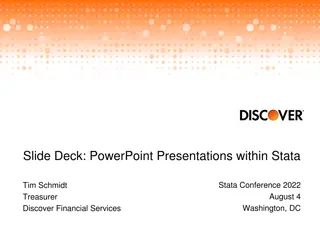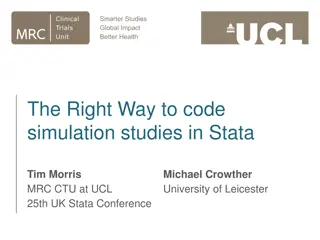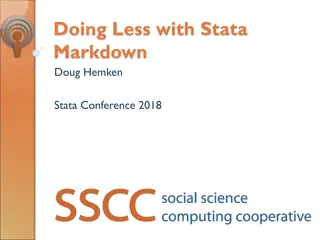Program Monitoring with Topic Modeling in Stata
Explore how topic modeling using Stata aids in monitoring tablet-based educational interventions in Sub-Saharan Africa. Learn about the program's context, methodology, and results to enhance implementation quality. Popular
Download Presentation

Please find below an Image/Link to download the presentation.
The content on the website is provided AS IS for your information and personal use only. It may not be sold, licensed, or shared on other websites without obtaining consent from the author.If you encounter any issues during the download, it is possible that the publisher has removed the file from their server.
You are allowed to download the files provided on this website for personal or commercial use, subject to the condition that they are used lawfully. All files are the property of their respective owners.
The content on the website is provided AS IS for your information and personal use only. It may not be sold, licensed, or shared on other websites without obtaining consent from the author.
E N D
Presentation Transcript
Program monitoring of educational tablet-based interventions using topic modeling in Stata Abraham Bahlibi, Imagine Worldwide Stata Conference July 21st, 2023 1
Table of Contents Introduction Background Pilot Context and Methodology Process is Stata Results Takeaways and Challenges References 2
Introduction The Context Following a phase of rigorous efficacy research, Imagine Worldwide is working with partners to scale a tablet-based education intervention in several Sub-Saharan African countries. The program is expanding from dozens to hundreds and soon thousands of schools in these locations. The Problem Program monitoring is critical for maintaining the quality of implementation and outcomes for the educational tablet-based intervention as we scale. During program monitoring, we collect large amounts of qualitative data and need a method for analyzing it quickly to make it actionable. Pilot Purpose To test using topic modeling to support program monitoring by summarizing key topics in large datasets of text observations that were logged during the implementation of the tablet program. To identify implementation issues by using the LDAgibbs Stata package, which runs the topic modeling algorithm, while also testing to see how well the Stata package generates topics to assist monitoring. 3
THE LEARNING CRISIS Talent is universal, but opportunity is not Over 500M children do not attain basic literacy and numeracy skills globally ENORMOUS NEED FOR SCALABLE SOLUTIONS LOW PERFORMANCE OF SCHOOLS 89% 450M children will be born in Africa in the 2020s** and by 2030 young Africans will be 42% of global youth*** of children in Sub-Saharan Africa are unable to read and understand a simple text by the age of 10* 4
Description of the Tablet Program Research-based, award-winning software by onebillion Child centered, personalized learning Provides instruction in foundational literacy and numeracy Available so far in Chichewa, Kiswahili, English, and French For use primarily with Grades 1-4 Supplemental to normal school instruction Tablet sessions run 30-60 min daily; 4-5 sessions per day are possible Adults play a facilitative role Tablets are charged using solar power There are local variations in how the program is implemented
THE RESULTS Our rigorous research* on the tablet program has shown strong gains in literacy and numeracy, plus stakeholders report increased student enrollment and improved attendance, engagement, and confidence as learners 4.2 72% 50% Gender Equity more children advanced on national literacy benchmarks months of additional literacy learning after 13 months of disrupted learning due to COVID attained emergent or fluent mathematics status after 13 months boys and girls had similarly positive results * Find research studies on our website: https://www.imagineworldwide.org/resources/ 6
Pilot Context Setting and implementation 19 schools in Liberia and 13 schools in Ghana Average learners per tablet session Ghana: ~28 learners (min= 3 and max =62) Liberia: ~25 learners (min=3 and max =89) Learners are given their own tablet to work on for the session Teachers are trained by our implementation partners on how to run the program Program monitoring activities Each of the schools has a dedicated field officer The field officer performs weekly visits to observe the implementation of the tablet program The field officer also is tasked with weekly submission of a tablet program monitoring survey Data from the tablet program monitoring survey is what is used for our analysis Date range for the pilot monitoring survey data: October 11th, 2021 - ongoing 7
Monitoring Methodology Program monitoring survey Purpose: For field officers to log observations from their site visits. Field officers observe the classroom session of the tablet program, fill out the program monitoring survey, and uploads the surveys to the internet. Field officers are prompted to make comments about 6 types of observations: Tablet use by learners Session setup Environment of the classroom Closing the session Technical issues Other issues Data collection: Field officers use a mobile data collection application on a mobile device to log survey responses. After the mobile device uploads the data to the internet, it is then downloaded as an excel file. The excel file contains field officer name, country name, school name, timestamps, and open- ended responses from field officers observations. 8
Topic Modeling Methodology What is topic modeling/Latent Dirichlet Allocation (LDA)? LDA is a natural language processing and machine learning technique that aims to discover main themes or topics within a collection of documents. In this case, the documents are comments that were logged by field officers. LDA groups words from the comments into topics based on how frequently certain words appear together. LDA helps us understand a large collection of comments without having to read each one. Assumptions and limitations LDA assumes that the collection of comments contains a mixture of topics. LDA also assumes that the order of words in a comment does not matter and only considers the frequency of words. Topic modeling does not possess semantic understanding. 9
Procedure in Stata Step 1: Import the tablet monitoring survey excel file into Stata. Step 2: Make sure comments are in one column. Step 3: Use stritrim command on the comments variable to get rid of additional spaces. Also, use the lower command to make all words in lowercase. Step 4: Use the txttool command to remove punctuations. Step 5: Drop comments that have no context. For example, comments that only have N/A or OK were dropped. Step 6: Load in a stopwords.txt file that contains stop words. Stop words are articles, prepositions, pronouns, conjunctions, and common verbs. We then use the txttool command to load in the .txt file to exclude the stop words from the analysis. Step 7: Run the LDAgibbs command. Before running the command, we must specify how many topics we think there are in the data. We selected for LDAgibbs to identify 5 topics for our analysis. LDAgibbs first randomly assigns each word to a topic. It then makes many iterations and updates the probability a word belongs to each of the topics. 10
Results Top 10 words associated with each of the 5 topics The results are from 524 tablet use observations from Ghana Overall program performance Topic 2, topic 3, topic 5: support, assisting, and supervise Program issues Topic 1: Windows and noise Topic 4: Issues, noisy, cables, and headphones 11
Results Top comments from topic 1: Learners near the windows were making noise Students from the JHS were standing by windows talking which was a bit distracting the tablets sessions. The facilitator was present and supervision the tablet session. Noise from others students, students standing by the windows. Top comments from topic 2: Teachers actively supervising learners on the tablets Teacher and volunteer walking round to observe and give assistance to students who are stuck in answering questions or challenge in hearing. Very quiet and concentrated class with teacher and volunteer walking round to support interns hearing and stuck in answering questions . Top comments for topic 4: Faulty audio cables led to headphones not working. This led to many tablets producing sound from their speakers, which made the classrooms noisy As a result of audio cables being faulty, session was noisy The session continued to be noisy due to faulty audio cables
Takeaways and Challenges Takeaways Topic modeling worked as expected We made inferences from the topic modeling results and identified program performance and issues that were reported in the field officers We followed up with the monitoring team and shared the results from topic modeling Challenges Not enough data yet Pilot data was limited to 524 observations. Topic modeling groups words into topics more clearly with more observations Comments are not long enough It is recommended that comments are at least 50 100. We are considering feasible methods for obtaining meaningful longer comments. 13
References Schwarz, C. (2018). ldagibbs: A command for topic modeling in Stata using latent Dirichlet allocation. The Stata Journal, 18(1), 101-117. Levesque, K., Bardack, S., Chigeda. A. (2020). Tablet-based learning for foundational literacy and math: An 8-month RCT in Malawi. Research report prepared for Imagine Worldwide. Retrieved from: https://www.imagineworldwide.org/wp-content/uploads/An-8-month-RTC-in-Malawi_Final-Report_ Jan-2020.pdf Pitchford, N. J., Hubber, P. J., & Chigeda, A. (2017). Unlocking Talent: Improving Learning Outcomes of Primary School Children in Malawi. Unpublished report. Wencker, T. (2019). Policy Brief: Text Mining. German Institute for Development Evaluation. Retrieved from https://www.deval.org/fileadmin/Redaktion/PDF/05-Publikationen/Policy_Briefs/2019_1_Text_Min ing/DEval_Policy_Brief_Text_Mining_2019_EN.pdf 14
Stay connected with Imagine Follow us on social media or sign up for our newsletter imagineworldwide.org
